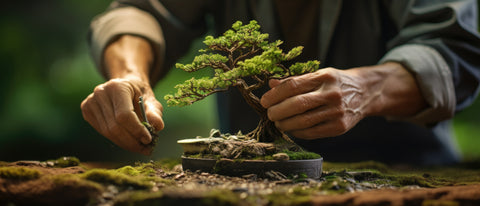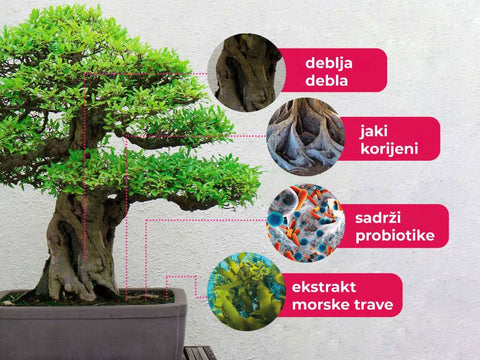These plants, with special care and shaping, retain the appearance of a mature tree in nature – but in a smaller form. It originated in China, where the practice was called penjing, but its current form was most developed in Japan. The word bonsai in Japanese means “tree in a tray” (bon = tray, sai = plant).
In the world of gardening, bonsai represents the intertwining of nature, art, and patience. By shaping branches, pruning roots, and controlling growth, the gardener directs the development of a tree over years or even decades. The goal is not just miniature, but a harmonious form that expresses the tree's natural beauty and character.
Bonsai is not just a decoration, but often a symbol of inner peace, balance and respect for nature. It requires precision, patience and long-term commitment, which is why it is considered a special and respected discipline among the horticultural arts.
🌿 We present you some sets from our collection
A starter set that contains everything you need to grow your own bonsai. The seeds are hand-selected and tested and allow you to grow 4 types of the most sought-after bonsai trees. Our set offers everything to explore the wonderful world of bonsai. We made sure that you don't even need to buy any supplements at the beginning of weight gain. And to cheer you up, we have added 2 different seeds for FREE.
These seeds are: Japanese red maple, Judas tree, Wisteria, Japanese black pine, Fire tree, Mimosa.

This Bonsai Easy Set contains 8 different types of seeds of the best plants that are popular among bonsai collectors. These plants are: Mimosa, Flame Tree, Rosehip, Blue Spruce, Jacaranda, Eucalyptus, Wisteria, Japanese Black Pine.
 .
.
Italian pine Pinus Pinea gives a beautiful crown and a beautiful view. The seeds will germinate indoors. A set for beginners or top masters. It is a great gift idea for a friend. The set includes a unique ceramic pot, seeds, biodegradable pots and coconut soil lozenges.

Discover the joy of growing the legendary tree - the ginkgo. This set is suitable for beginners and those who have already mastered this type of gardening. The ginkgo is a beautiful ancient tree with bright yellow leaves.

The red maple with its small red pointed leaves will attract you at every turn. The set contains everything you need to start growing at home in a pot. It is suitable for growing indoors all year round.

If you want to learn more about the history of bonsai trees and the style of the trees, you can read more about it in the e-book.
Here you will learn everything you need to know about each plant, planting, pruning, wiring, watering and fertilizing.
🌿 Characteristics of bonsai formation
The formation of bonsai is a fundamental part of this art, as each form expresses a certain aesthetic, a sense of movement and the symbolism of the natural environment. The forms are created based on the observation of trees in nature and have Japanese names. Below are the most common traditional bonsai forms and their characteristics:
1. Chokkan (upright form)
Characteristics: The tree grows upright, the trunk is straight and evenly thickened towards the bottom. The branches are symmetrically arranged and thin towards the top.
Symbolism: Strength, stability, dignity.
2. Moyogi (irregular upright shape)
Characteristics: The trunk curves gracefully, but the final top of the tree always grows straight up. Branches emerge from the outer curved parts.
Symbolism: Adaptability, life's journey with ups and downs.
3. Shakan (tilted form)
Characteristics: The tree is tilted at an angle, as if bent by wind or light. The roots are firmly anchored in the substrate to maintain balance.
Symbolism: Perseverance, strength in adverse conditions.
4. Kengai (horizontal or cascade form)
Characteristics: The tree descends below the level of the root base, as if hanging from a cliff. A special tall container is often used.
Symbolism: Natural forces, such as the weight of snow or wind, and the struggle for survival.
5. Han-Kengai (semi-cascade form)
Characteristics: Similar to the kengai shape, but the stem stops just below the rim of the bowl. The stem curves downwards and then slightly upwards again.
Symbolism: Adaptation to difficult conditions, balance.
6. Fukinagashi (Wind-bent shape)
Characteristics: All branches and trunk are bent in one direction, as if shaped by strong winds over a long period of time.
Symbolism: Perseverance despite adverse natural influences.
7. Sokan (Double trunk)
Characteristics: Two trunks, often larger and smaller, grow from a single base, creating a sense of family or harmony.
Symbolism: Family, togetherness.
8. Yose-ue (Forest Group)
Characteristics: A group of several trees of varying sizes, which together represent a natural forest. The trees are arranged to create depth and balance.
Symbolism: Community, nature as a whole.
9. Ikadabuki (Raft shape)
Characteristics: One thick, straight trunk from which more trees grow than would grow on a raft.
Symbolism: Continuation of life, reconstruction after a disaster.
🌿 What if we decide to grow bonsai ourselves at home?
Bonsai can also be grown at home, although it requires patience, precision and a love for the plants. First, we choose a suitable type of tree - for beginners, species such as ficus, maple, pine, spruce or Chinese elm are recommended. Bonsai can be grown from seeds, cuttings or young seedlings.
The plant can be grown from seed or started as a seedling, planted in a suitable container with good drainage and quality bonsai soil. This is followed by gradual shaping - by pruning branches and roots we direct growth and maintain the desired size. The shape of the tree is also determined by using wire, which is carefully wrapped around the branches and directed.
Proper care is very important: regular watering (bonsai cannot tolerate drought), fertilization and enough light. Most species need a lot of light and ventilation, so it is recommended to move the bonsai outdoors in the summer.
Growing bonsai is a time-consuming but rewarding process that develops an eye for detail and a connection to nature. With a little knowledge and effort, you can create your own living work of art.




